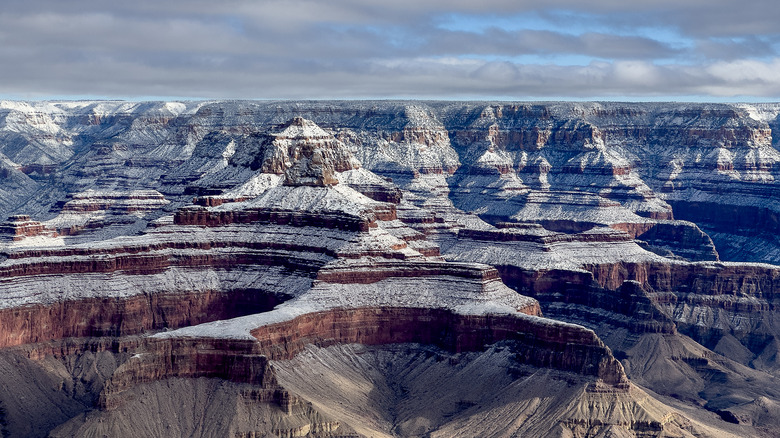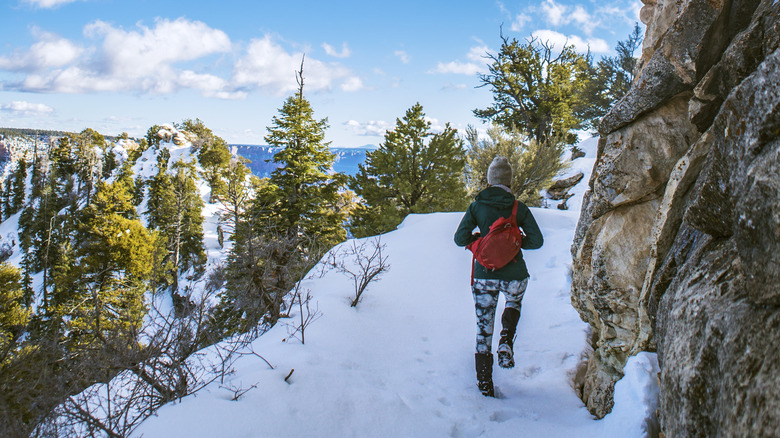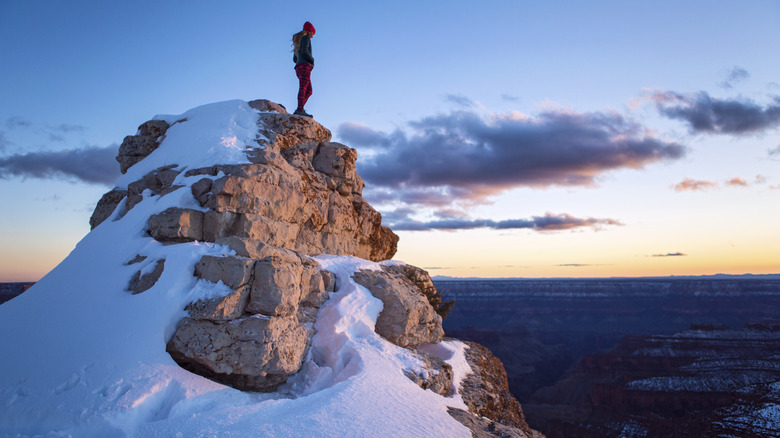The Scary Reason This Iconic Section Of The Grand Canyon Closes For Part Of The Year
The mighty Grand Canyon may be America's most iconic landmark. At the very least, Grand Canyon National Park is one of the most popular parks in America's National Park System, with more than 4,700,000 visitors in 2023 alone. While this popularity is certainly warranted, it can also pose problems for any prospective future visitors. Large crowds and heavy traffic in peak tourist areas can sully the otherwise incredible experience of witnessing the Grand Canyon in person.
The good news is that Grand Canyon National Park has a lesser-known side you can explore. The Grand Canyon's North Rim only receives about 10% of the Grand Canyon's annual visitors. Compared to the much more popular South Rim, the North Rim displays all of the same magnificent views (including some rarely seen on postcards and social media) without excessive crowding, traffic jams, and packed parking areas. Many experienced hikers consider the North Rim's Bright Angel Point and North Kaibab trails to offer some of the most iconic views in the entire Grand Canyon. All-in-all, the North Rim is one of the best lesser-known destinations in an otherwise popular national park.
But the North Rim's advantages come with a catch. As amazing as this underrated area is, it's only accessible to most travelers during the warmer months. In the winter, inclement weather, brutal conditions, and a lack of infrastructure make the area too dangerous for all but the most experienced and self-sufficient travelers. Between December 1 and May 14, all roads into the North Rim area of the park close down, as do all of the unit's visitor centers. Brave travelers who do make the challenging winter backpacking journey to the North Rim should expect scary conditions, remote locations, and a lack of essential services.
Why the North Rim is so dangerous in the winter
The main danger of Grand Canyon winters may be how few visitors come prepared for it! The Grand Canyon is located in Arizona, a state that's rarely associated with cold and snowy weather. But reputations can be deceiving, especially in a climate as dramatic as the Grand Canyon's. While Grand Canyon National Park does uphold standard Arizona temperatures in the summer, come winter the park can experience both frigid cold and heavy snow. Even at the more accessible South Rim, visitors expecting a warm and sunny respite from winter weather may be in for an unpleasant surprise.
The park's harsh winters are even worse at the North Rim. On average, North Rim winters see both colder temperatures and heavier precipitation. In the winter of 2022-2023, the North Rim received 246.7 inches of snow, with an average snow depth of around 40 inches (via Grand Canyon Conservancy)! Average high temperatures in the North Rim only hit the upper 30s in January and February, with many days seeing consistent temperatures below freezing. The North Rim's North Kaibab Trail may be one of the most beautiful underrated hikes in America's national parks, but dangerous cold and heavy snowfall can quickly turn even top hikes into brutal slogs through unsafe conditions.
What's worse, the Grand Canyon's North Rim does not have anywhere near the infrastructure needed to accommodate winter weather. Unlike the South Rim, the North Rim lacks accessible roads and a reliable power grid, which makes it nearly impossible to accommodate the necessary corps of rangers and support staff during the winter. Even though the North Rim's main roads and visitor centers close on December 1, anyone visiting as early as October should prepare for limited services and self-sufficiency.
You can still enjoy the Grand Canyon during the winter season
As scary as all this sounds, the Grand Canyon is still a great national park to visit in the winter (at least in its better-developed areas). You just have to be a bit more prepared. The Grand Canyon's North Rim does close for the winter season, but the South Rim remains open year-round. Barring particularly nasty winter conditions, you will be able to visit popular South Rim observation areas like Mather Point and Desert View even in the heart of the winter season.
While these areas are certainly spectacular in the warmer months, a visit during the winter can provide a once-in-a-lifetime view of the magnificent Grand Canyon decked in a surreal, yet breathtaking, cover of white snow — not to mention the smaller crowds. Still, winter conditions can be harsh even in the more accessible South Rim. If you do choose to visit in the winter, make sure you check weather forecasts and road conditions, bring adequate supplies, and heed any official warnings or closures.


